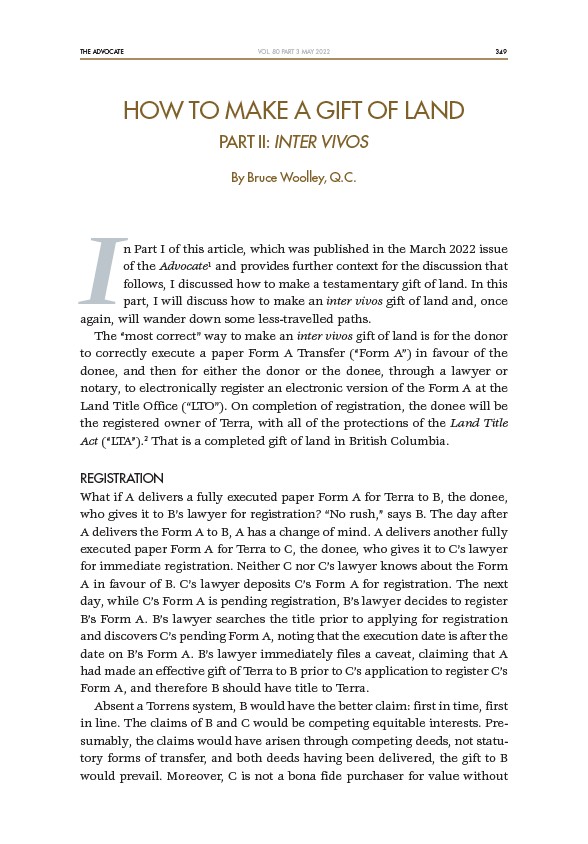
THE ADVOCATE 349
VOL. 80 PART 3 MAY 2022
HOW TO MAKE A GIFT OF LAND
PART II: INTER VIVOS
By Bruce Woolley, Q.C.
In Part I of this article, which was published in the March 2022 issue
of the Advocate1 and provides further context for the discussion that
follows, I discussed how to make a testamentary gift of land. In this
part, I will discuss how to make an inter vivos gift of land and, once
again, will wander down some less-travelled paths.
The “most correct” way to make an inter vivos gift of land is for the donor
to correctly execute a paper Form A Transfer (“Form A”) in favour of the
donee, and then for either the donor or the donee, through a lawyer or
notary, to electronically register an electronic version of the Form A at the
Land Title Office (“LTO”). On completion of registration, the donee will be
the registered owner of Terra, with all of the protections of the Land Title
Act (“LTA”).2 That is a completed gift of land in British Columbia.
REGISTRATION
What if A delivers a fully executed paper Form A for Terra to B, the donee,
who gives it to B’s lawyer for registration? “No rush,” says B. The day after
A delivers the Form A to B, A has a change of mind. A delivers another fully
executed paper Form A for Terra to C, the donee, who gives it to C’s lawyer
for immediate registration. Neither C nor C’s lawyer knows about the Form
A in favour of B. C’s lawyer deposits C’s Form A for registration. The next
day, while C’s Form A is pending registration, B’s lawyer decides to register
B’s Form A. B’s lawyer searches the title prior to applying for registration
and discovers C’s pending Form A, noting that the execution date is after the
date on B’s Form A. B’s lawyer immediately files a caveat, claiming that A
had made an effective gift of Terra to B prior to C’s application to register C’s
Form A, and therefore B should have title to Terra.
Absent a Torrens system, B would have the better claim: first in time, first
in line. The claims of B and C would be competing equitable interests. Presumably,
the claims would have arisen through competing deeds, not statutory
forms of transfer, and both deeds having been delivered, the gift to B
would prevail. Moreover, C is not a bona fide purchaser for value without